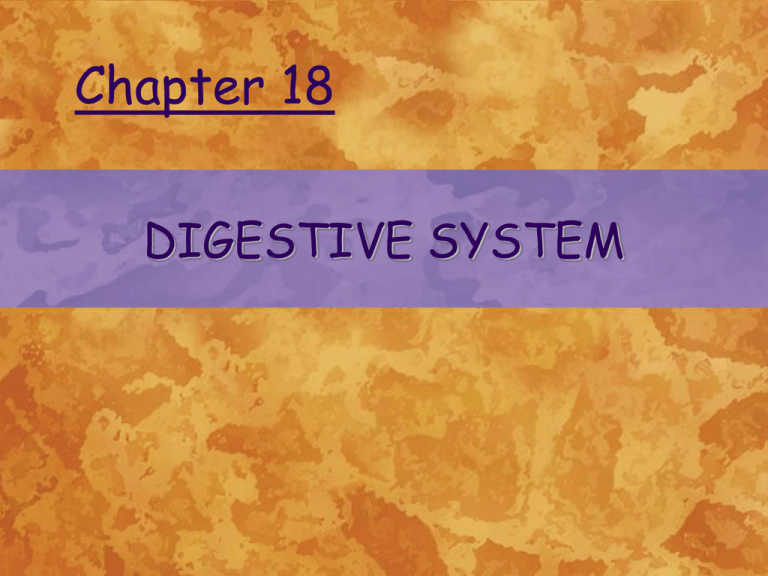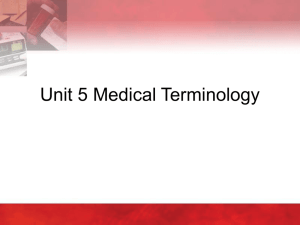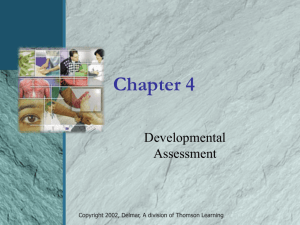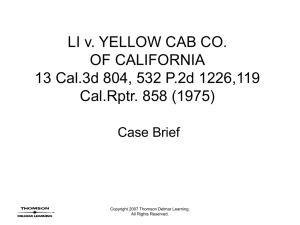PowerPoint
advertisement

Chapter 18 DIGESTIVE SYSTEM LINING OF THE DIGESTIVE SYSTEM • Peritoneum - two-layered membrane – Mesentery - part that attaches to posterior wall of abdominal cavity – Greater omentum - anterior portion that protects abdominal organs © 2004 Delmar Learning, a Division of Thomson Learning, Inc. FUNCTIONS OF THE DIGESTIVE SYSTEM • Break food into smaller pieces • Change food chemically into fat, carbohydrates, and protein • Absorb nutrients into blood capillaries of small intestines • Eliminate waste products of digestion © 2004 Delmar Learning, a Division of Thomson Learning, Inc. ORGANS OF DIGESTION © 2004 Delmar Learning, a Division of Thomson Learning, Inc. ORGANS OF DIGESTION • Many organs contribute to digestion – Mouth – Tongue – Salivary glands © 2004 Delmar Learning, a Division of Thomson Learning, Inc. ORGANS OF DIGESTION © 2004 Delmar Learning, a Division of Thomson Learning, Inc. TEETH/ ACCESSORY ORGAN OF DIGESTION • Structure of a tooth – Crown – Neck – Root – Periodontal membrane – Pulp cavity – Dentin – Enamel © 2004 Delmar Learning, a Division of Thomson Learning, Inc. ESOPHAGUS • The esophagus is a muscular tube beginning at the lower end of the pharynx, passing through the diaphragm and connecting to the upper portion of the stomach © 2004 Delmar Learning, a Division of Thomson Learning, Inc. STOMACH • Stomach is divided into 3 portions – Fundus - upper part – Greater curvature (body) - middle – Pylorus - lower portion • Gastric juices are secreted by millions of gastric glands © 2004 Delmar Learning, a Division of Thomson Learning, Inc. SMALL INTESTINE • The final preparation of food to be absorbed occurs in the small intestine • Divided into three sections – Duodenum – Jejunum – Ileum © 2004 Delmar Learning, a Division of Thomson Learning, Inc. SMALL INTESTINE • Digestive juices – Enzymes, secretin, cholecystokinin stimulate digestive juices – Pancreatic juices break down food – Bile emulsifies fat – Intestinal juices break food down further for absorption © 2004 Delmar Learning, a Division of Thomson Learning, Inc. SMALL INTESTINE • Absorption in the small intestine is accomplished through millions of villi. • The indigestible portion is passed through to the large intestine © 2004 Delmar Learning, a Division of Thomson Learning, Inc. LIVER/ACCESSORY ORGAN OF DIGESTION • Functions of the liver – Manufactures bile which is necessary for fat digestion – Produces and stores glucose in the form of glucogen – Detoxifies alcohol, drugs and other harmful substances – Manufactures blood proteins © 2004 Delmar Learning, a Division of Thomson Learning, Inc. LIVER/ACCESSORY ORGAN OF DIGESTION • Prepares urea, the chief waste product of protein metabolism • Stores vitamins A, D, and B complex • Breaks down hormones no longer useful to the body • Removes old red blood cells and recycles iron content © 2004 Delmar Learning, a Division of Thomson Learning, Inc. GALLBLADDER • The gallbladder stores and concentrates bile when it is not needed by the body © 2004 Delmar Learning, a Division of Thomson Learning, Inc. LARGE INTESTINE • Chyme is semi-liquid food in the large intestine • Colon – Ascending – Traverse – Descending • Anal Canal © 2004 Delmar Learning, a Division of Thomson Learning, Inc. GENERAL OVERVIEW OF DIGESTION • • • • • • Mouth Pharynx Esophagus Stomach Small Intestine Large Intestine © 2004 Delmar Learning, a Division of Thomson Learning, Inc. COMMON DISORDERS OF THE DIGESTIVE SYSTEM • • • • • • • Stomatitis Gastroesophageal reflux disease Hiatal hernia Heartburn Gastritis Gastoenteritis Enteritis © 2004 Delmar Learning, a Division of Thomson Learning, Inc. COMMON DISORDERS OF THE DIGESTIVE SYSTEM • • • • • • • Ulcer Inflammatory bowel disease Appendicitis Hepatitis Cirrhosis Cholecystitis Gallstones © 2004 Delmar Learning, a Division of Thomson Learning, Inc. COMMON DISORDERS OF THE DIGESTIVE SYSTEM • • • • • • Pancreatitis Diverticulosis Diarrhea Constipation Stomach cancer Colon cancer © 2004 Delmar Learning, a Division of Thomson Learning, Inc.







